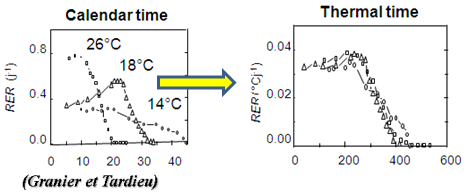Preliminary Course.
Eco-Physiology
Factors affecting plant growth
Thermal Time
Temperature controls both organogenesis (organ appearance) and organ growth.
-
Thermal Time Tt is measured by calculating the daily accumulations of heat using temperature data.
Thermal time is expressed in Growing Degree Days (GDD).
-
Tt = Σd=1,n ( Td - To )
where
-
Td is the average daily temperature
To is the developmental threshold or base temperature under which the development rate is zero. The base temperature varies with the plant species: 0°C for wheat, 4°C for barley, 8°C for soybean, and 10 °C for maize, rice.
It is assumed that Td ≥ To, if not, Td is set to To.
Thermal Time and Organogenesis
-
It has been shown that the number of organogenesis cycles is proportional to the thermal time.
The following example illustrates this property on leaf appearance.

Number of leaves produced in successive periods at various temperatures (Graph: J. Lecoeur, INRA-SYGENTA)
Graphs according to calendar time (top left) and to thermal time (bottom).
On the calendar time data, leaf appearance alignments are spread on the graph, with high temperatures on the left, and low ones on the right.
Normalizing the period duration to the thermal time (right) leads to a single linear leaf appearance rate.
Thermal Time and Development.
-
This rule can also be applied to organ size increase.
It has been shown that biomass increases are proportional to thermal time.
Normalizing the development time with thermal time (instead of calendar time) allows development comparisons as illustrated below on elongations.

This example illustrates the Relative Elongation Rate (RER) measured according to calendar time (per day) compared to thermal time (expressed in oC per day). (Graph: Granier and Tardieu, INRA)
Bibliography
Interesting reading related to thermal time:
Granier, C., Massonnet, C., Turc, O., Muller, B., Chenu, K., and Tardieu, F. 2002. Individual Leaf Development in Arabidopsis thaliana: a Stable Thermal-time-based Programme. Annals of Botany (2002) 89 (5): pp. 595-604 (access to paper and pdf)
Lecoeur J., Ney B. 2003. Change with time in potential radiation use efficiency in field pea, European Journal of Agronomy. vol. 19, pp. 91-105
